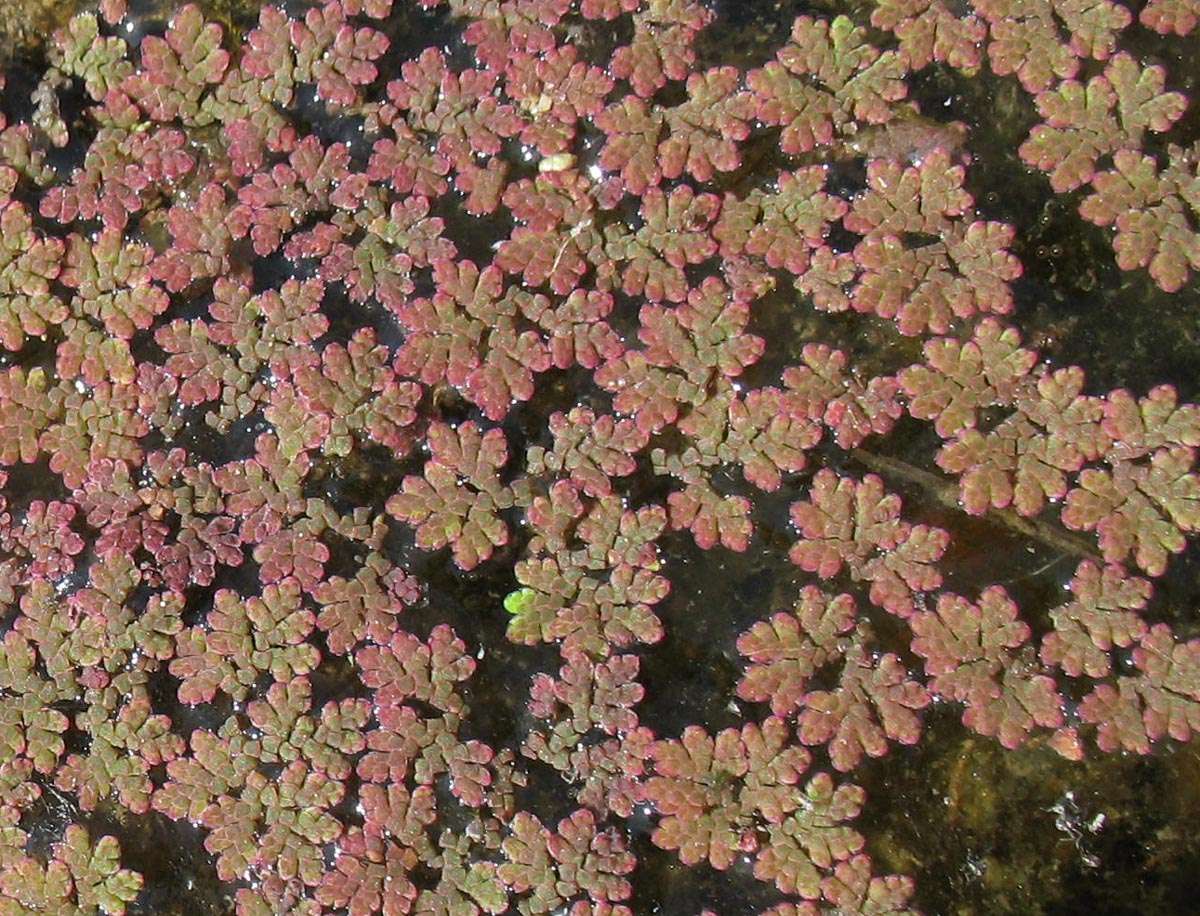
|
Family: Salviniaceae |
Roots 3--5 cm. Stems prostrate, 1--3 cm, or nearly erect, 3--5 cm, hairs absent. Leaves with 1(--2)-celled hairs on upper surface of upper lobe. Sporocarps in pairs. Megasporocarp megaspore with 3 floats. Microsporocarp masses entirely covered with arrowlike barbs. x = 22. Azolla is divided into sect. Azolla and sect. Rhizosperma (Meyen) Mettenius, which are sometimes recognized as subgenera. New World species belong to sect. Azolla and differ from sect. Rhizosperma by having 3 floats per megasporocarp (fig. 25.1), subdichotomous branching, and straight barbs on microsporangial masses (rather than 9 floats per megasporocarp, pinnate branching, and needlelike hairs or hairs absent on microsporangial masses). The genus was more diverse in past geologic ages: 30 species are known from the Cretaceous (J. W. Hall 1974). The species of Azolla are difficult taxonomically because (1) about 80% of the specimens lack sori, which are necessary for identification, and (2) the characteristics needed to identify the species are difficult to observe. A scanning electron microscope is needed to see sculpturing of the megaspores, and a light microscope is needed to see the number of cells per hair on the upper leaf lobe. (These hairs are best seen in profile on mature leaves; at least 40× magnification is needed.) Previous workers emphasized the number of septae (internal partitions) in the barbs on the microsporangial masses as a primary differentiating characteristic among species of Azolla (e.g., H. K. Svensen 1944). This character is not constant, however, either within a species or within an individual (R. K. Godfrey et al. 1961; L. V. Hill and B. Gopal 1967; K. Seto and T. Nasu 1975). Because nearly all floristic work in North America since the 1940s has been based on Svenson's synoptic treatment, the identity of most specimens is questionable, and therefore ranges are imprecisely known. The maps for this treatment are tentative. For the most part, I have noted occurrences only in those states or regions from which specimens have been identified using characteristics given in this key. Literature that attributes a particular species of Azolla to a particular state or province must be questioned because the specimens were presumably identified using the inconsistent glochidial characteristics given by H. K. Svenson (1944). More work is needed to determine the distribution of Azolla species in North America. Agriculturally, Azolla is famous for its symbiosis with the nitrogen-fixing Anabaena azollae Strasburger, a cyanobacterium (blue-green alga) found at the stem apices, beneath indusia, and in cavities of the upper leaf lobes. Because the plants fix nitrogen, they are often used as a green fertilizer or mixed with livestock feed as a nutritional supplement. Azolla pinnata has been cultivated for many centuries in rice paddies of northern Vietnam and southeastern China, where it acts as a fertilizer after it decomposes. Azolla is the most frequently studied genus of ferns in the world because of its economic importance. The three North American species are naturalized in Europe and South Africa, and they have been introduced into Hawaii for horticulture and into Asia for agriculture. All species have been studied for agricultural uses in rice-producing areas. Azolla is PLANT: Annual or perennial floating aquatic herbs, sometimes stranded on mud, heterosporous. ROOTS: adventitious, appearing fascicled from the stem nodes, unbranched. STEMS more or less dichotomously branched, sometimes breaking apart with age. LEAVES: alternate, 2-ranked, slightly overlapping, sessile, deeply 2- lobed, the lobes lacking apparent venation, one lobe floating and green, the other submerged, translucent, and nonphotosynthetic. FLOATING LEAF LOBES: oblong-ovate to obovate, the adaxial (emergent) surface with moderate to dense, minute, papilla-like hairs, with narrow thin entire margins. SUBMERSED LEAF LOBES: slightly larger than the floating lobes, oblong-ovate to obovate, thin, membranous. SORI: borne in sporocarps. SPOROCARPS: of 2 types, usually on the same plant, globose or nearly so, each containing 1 sorus, some with 1 megasporangium containing 1 megaspore, others with numerous microsporangia, each containing 32 or 64 microspores, produced infrequently, in pairs on short submerged stem branches (Fig. 2). SPORANGIA: thin-walled, lacking an annulus, breaking open irregularly through decay. MEGASPORES: large (0.2-0.6 mm), more or less ovoid, differentiated into a basal hemispheric portion, a medial ring-like collar, and 3 apical sac-like floats, these covered by a more or less conical, cap (the remains of an indusium). MICROSPORES: dust-like (10-27 μm), trilete, globose, imbedded in 3 or 4 amorphous translucent masses of cells (massulae), these with the outer surface usually bearing apically barbed trichomes. GAMETOPHYTES: reduced, developing inside the spores, the archegonia and antheridia protruding from the spore wall. X = 22. NOTES: 1 genus, ca. 7 spp., nearly worldwide. REFERENCES: Yatskievych, G. and M.D. Windham. 2008. Vascular Plants of Arizona: Azollaceae. CANOTIA 4 (2): 31-34, 2008. Delicate, moss-like plants, subdichotomously branched above every third lf; roots slender, simple, inconspicuous; lvs alternate, minute, sessile, unequally bilobed, one lobe submersed and serving as a float, the other smaller, emersed, and containing a colony of a symbiotic blue-green alga, Anabaena azollae; sporocarps borne on the first leaf of a branch, paired at the tip of a short, bipartite secondary lobe originating from the submersed lobe near its base, appearing almost axillary; microspores 32 or 64, aggregated into 4 or more massulae, each massula with its own thin wall, which bears numerous slender appendages (glochidia) with terminal, retrorse hooks; megaspore with a hemispheric or broadly bell-shaped basal part and a sharply marked, complex, conical terminal part that eventually shows 3 basally spreading, apically confluent, longitudinal valves. 6, cosmop. Gleason, Henry A. & Cronquist, Arthur J. 1991. Manual of vascular plants of northeastern United States and adjacent Canada. lxxv + 910 pp. ©The New York Botanical Garden. All rights reserved. Used by permission. |



